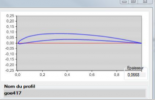Does somebody know, why the Mavic Air 2 propeller airfoils have a sharp leading and trailing edges, while common theory claims that leading edges should be rounded
You are using an out of date browser. It may not display this or other websites correctly.
You should upgrade or use an alternative browser.
You should upgrade or use an alternative browser.
Propeller Airfoil Shape
- Thread starter sigi.stiemer
- Start date
Leading edge is normally done for strength of the airfoil, so as DJI has a propulsion engineering section that designs from ESC, Motor to propeller I would have to give a guess that it was done as a resistance to drag and a noise factor...but just guessingDoes somebody know, why the Mavic Air 2 propeller airfoils have a sharp leading and trailing edges, while common theory claims that leading edges should be rounded
I am sure you know these things but just for some light reading: airfoils blade profile
Last edited:
hiflyer201
Well-Known Member
- Joined
- Sep 27, 2018
- Messages
- 2,740
- Reactions
- 2,167
The sharp edges prevent the formation of a detached bow shock in front of the airfoil as it moves through the air.
Thats the google answer
The clark Y is rounded for sure. Laminar flow is pretty pointed if your talking about slower aircraft.
Thats the google answer
The clark Y is rounded for sure. Laminar flow is pretty pointed if your talking about slower aircraft.
Hiflyer201, thanks for your answer. You are correct that sharp edges prevent the formation of a detached bow shock in front of the airfoil. A bow shock occurs when an object in the air reaches supersonic speeds (above 343 m/s).
A typical drone motor reaches a maximum speed of around 9600 RPM (Hacker Be20 26 L – 2080 KV motor). Teamed up with a rotor blade of 7” in diameter, one gets a tip speed of about 460 km/h. Let’s say the drone reaches a maximum flight speed of 40 mph (MA2), the resulting maximum speed for the rotor tips would be 525 km/h. This is less than half the speed of sound. Ergo: Bow shocks cannot be created by drone typical propellers, therefore sharp edges are not needed.
The question remains: Why have Mavic Air 2 propeller airfoils sharp leading (and trailing) edges?
A typical drone motor reaches a maximum speed of around 9600 RPM (Hacker Be20 26 L – 2080 KV motor). Teamed up with a rotor blade of 7” in diameter, one gets a tip speed of about 460 km/h. Let’s say the drone reaches a maximum flight speed of 40 mph (MA2), the resulting maximum speed for the rotor tips would be 525 km/h. This is less than half the speed of sound. Ergo: Bow shocks cannot be created by drone typical propellers, therefore sharp edges are not needed.
The question remains: Why have Mavic Air 2 propeller airfoils sharp leading (and trailing) edges?
The question remains: Why have Mavic Air 2 propeller airfoils sharp leading (and trailing) edges?Hiflyer201, thanks for your answer. You are correct that sharp edges prevent the formation of a detached bow shock in front of the airfoil. A bow shock occurs when an object in the air reaches supersonic speeds (above 343 m/s).
A typical drone motor reaches a maximum speed of around 9600 RPM (Hacker Be20 26 L – 2080 KV motor). Teamed up with a rotor blade of 7” in diameter, one gets a tip speed of about 460 km/h. Let’s say the drone reaches a maximum flight speed of 40 mph (MA2), the resulting maximum speed for the rotor tips would be 525 km/h. This is less than half the speed of sound. Ergo: Bow shocks cannot be created by drone typical propellers, therefore sharp edges are not needed.
The question remains: Why have Mavic Air 2 propeller airfoils sharp leading (and trailing) edges?
Why have Mavic Air 2 propeller airfoils sharp leading (and trailing) edges?The question remains: Why have Mavic Air 2 propeller airfoils sharp leading (and trailing) edges?
Isn't there a member of this forum who got some basic knowledge on this topic? Aren't propellers key elements of flying drones? Am I the only one who is not only concerned about ethics, regulations, technology, AND PHYSICS?
k9kids
Well-Known Member
Thanks k9kids, I knew the article by Jonathan Feist. It is nicely written, reads easily, and is very informative. However, he does not address anywhere the topic of the propeller airfoil.
The choice of a sharp leading edge for the airfoil of the DJI Mavic Air 2 (and others) propeller still has no published justification. - Surely, it can't be only because that this promotes worse injuries when touched in flight ...
The choice of a sharp leading edge for the airfoil of the DJI Mavic Air 2 (and others) propeller still has no published justification. - Surely, it can't be only because that this promotes worse injuries when touched in flight ...
I did it: I modified the airfoil according to textbook knowledge. The drone seems quieter and the batteries last longer - oh well, it might be it is only wishful thinking.
I could answer my initial question experimentally - no more response required. Thanks to all who tried to help.
I could answer my initial question experimentally - no more response required. Thanks to all who tried to help.
Marcass Carcass
Well-Known Member
It would be nice if to go to the hobby store and get some "real" props to modify and try out and see. But, they would not have any, for lack of a better term, counter rotating props....at least as far as I know. I may go and check it out. I know they have tons of them.....but I'm like you, why not go ahead and make complete airfoils? My conclusion is that its easier and cheaper, and could be because it's more responsive....I did it: I modified the airfoil according to textbook knowledge. The drone seems quieter and the batteries last longer - oh well, it might be it is only wishful thinking.
I could answer my initial question experimentally - no more response required. Thanks to all who tried to help
Last edited:
Prismatic
Well-Known Member
I curious about your method. Did you lightly sand off the sharp leading and trailing edges? If not that, what did you do?I did it: I modified the airfoil according to textbook knowledge. The drone seems quieter and the batteries last longer - oh well, it might be it is only wishful thinking.
I could answer my initial question experimentally - no more response required. Thanks to all who tried to help.
Just sanding would be like guessing, which is not good enough. I employed a modified commercial CFD program and computed for a dozen radial distances of the propeller the optimum leading edge profiles. It turned out that they were of a shape similar to inclined elliptical shapes. Then I produced templates for the profiles and while sanding and checking by templates I interpolated the profiles in between the template locations.I curious about your method. Did you lightly sand off the sharp leading and trailing edges? If not that, what did you do?
This was not rocket science, but it was so much work, that I am not going to do this again. Maybe one of these days one can buy such propellers from an industrial fabricator. This might take a while. At present, it seems that drone owners are mainly concerned about the colour or tip shapes of the propeller.
Last edited:
Nordflow
New Member
Looking at the entire part, I believe the answer may be as simple as a reduction of production costs.
Form the point of view of mould engineering and quantity of cycles the ideal airfoil shape is more expensive to manufacture.
Form the point of view of mould engineering and quantity of cycles the ideal airfoil shape is more expensive to manufacture.
Tentoes
Well-Known Member
Does somebody know, why the Mavic Air 2 propeller airfoils have a sharp leading and trailing edges, while common theory claims that leading edges should be rounded
I'm guessing for ease of manufacture.
RetiredInFL
Very Large Member
You might be right. That is probably the reason why you can get one set of four props for the Air 2 for the bargain price of $ 23.99 from Masterairscrew. Oh, I forgot you get "STEALTH" propellers ... and in colour!I'm guessing for ease of manufacture.
At very low Reynolds number flight (i.e drone flight) viscous effects are dominant, thus thin plate geometries are favorable over conventional aerofoils for their reduced drag and increased efficiency. A blunted leading edge at low Reynolds numbers can also cause severe leading-edge separation, the flow over the geometry at low Reynolds numbers is largely laminar, and consequently flow reattachment is difficult. For conventional aircraft, aerofoils can take highly cambered geometries without risk of separation due to turbulent boundary layers at higher Reynolds numbers.
I recall from my days modeling airflow between heatsink fins - air as a fluid goes weird at smaller geometries. I wasn't the owner of the code I was using, and not an expert of the subject. I just recall having to do extraneous things with fan energies when heatsink fins were too close together - and not entirely due to back pressures created. What works for large props begins to fail as the prop gets smaller.
But then, manufacturing costs could be part of it too - though the cheapest model plane props often have reasonable airfoils.
But then, manufacturing costs could be part of it too - though the cheapest model plane props often have reasonable airfoils.
Amazon.com: You Make 10-Pack - 6" Plastic Propeller with Metal Shaft and Plastic Mount for Craft Sticks, Ideal for Rubber Band Powered Science and Engineer Projects Like Airplanes and Helicopters : Toys & Games
Buy You Make 10-Pack - 6" Plastic Propeller with Metal Shaft and Plastic Mount for Craft Sticks, Ideal for Rubber Band Powered Science and Engineer Projects Like Airplanes and Helicopters: Propellers - Amazon.com ✓ FREE DELIVERY possible on eligible purchases
www.amazon.com
One can make the leading edge as sharp as possible: even for viscous type flow one will always get a stagnation point. However, the sharper the edge is the more critical is its location and may cause unwanted split of the air above and below the foil. With a rounder edge the separation point gets a bit more freedom to locate thus securing a better division in the flow.
Similar threads
- Replies
- 7
- Views
- 884
- Replies
- 5
- Views
- 833
- Replies
- 10
- Views
- 1K
- Replies
- 14
- Views
- 604
DJI Drone Deals
New Threads
-
-
-
2 Enterpise Shawn Ryan Shocked by Police Drone Capable of Reaching 100MPH
- Started by bmwbob
- Replies: 2
-
4 Pro Insane Views: Pictures and Videos Of Utah
- Started by jaystechvault
- Replies: 0
-
Best Stock Photo and Video Site For Drone Pilots
- Started by jaystechvault
- Replies: 0










